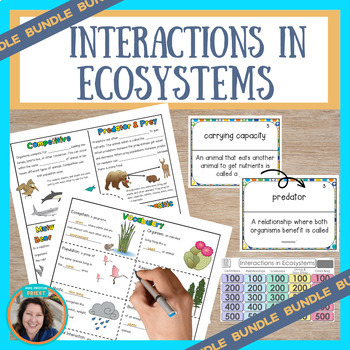Interactions in Ecosystems - Abiotic and Biotic Factors - Activities & Game
- Zip
Products in this Bundle (2)
Description
Save 10% on these activities teaching about interactions in ecosystems. These LOW PREP ecosystem notes and science game help middle school science students learn about how changes in abiotic and biotic factors impact ecosystems and predict outcomes. Students explore predator and prey, competitive, mutually beneficial, commensalism, and parasitic relationships in ecosystems while predicting changes that might happen in a population or community.
Please click the PREVIEW to see what is included in this ready-to-use resource.
Included in this ecosystem resource for 7th grade:
- These visual notes cover the basics including the definition of ecosystems, organisms, abiotic and biotic factors, population, resources, and interdependent and dependent relationships.
- Interactive guided sketch notes cover middle school science topics in a visual manner.
- Students identify abiotic and biotic factors in ecosystem scenarios.
- Students are provided scenarios where they identify the ecosystem interaction and predict outcomes.
- A slideshow guides students as they fill out their notes and learn about interactions in ecosystems.
- Claim Evidence Reasoning or CER prompt on ecosystem resources with a rubric and sample answer key is included. CER science writing encourages critical thinking and is great for practice and assessment.
- Digital and printable options for a quiz are included
- 20 question science scavenger hunt or science center review game
- Jeopardy on Google Slides game
These middle school science notes work towards mastering
NGSS MS-LS2-2 Construct an explanation that predicts patterns of interactions among organisms across multiple ecosystems. Clarification Statement: Emphasis is on predicting consistent patterns of interactions in different ecosystems in terms of the relationships among and between organisms and abiotic components of ecosystems. Examples of types of interactions could include competitive, predatory, and mutually beneficial.
I LOVE MY FOLLOWERS!
Click on the green ★ to follow my store and get notifications about new resources and freebies!
Thank you for visiting my store!
Let's Connect!
Mrs. Proton Priest on Facebook
Mrs. Proton Priest on Pinterest
WOULD YOU LIKE TO EARN FREE PRODUCTS?
To earn TPT credits to use on future purchases:
Go to your "My Purchases" page. Beside each purchase, you'll see a "Provide Feedback" button. Leave a rating and leave a short comment on the product. You can check your credit balance on your TpT Credit Balance page. Apply credits towards future TpT purchases in my store, or any TpT store. I value and appreciate your feedback!
****************************************************************************************
Copyright © Ginny Priest, Mrs. Proton Priest. All rights reserved by the author.
****************************************************************************************





